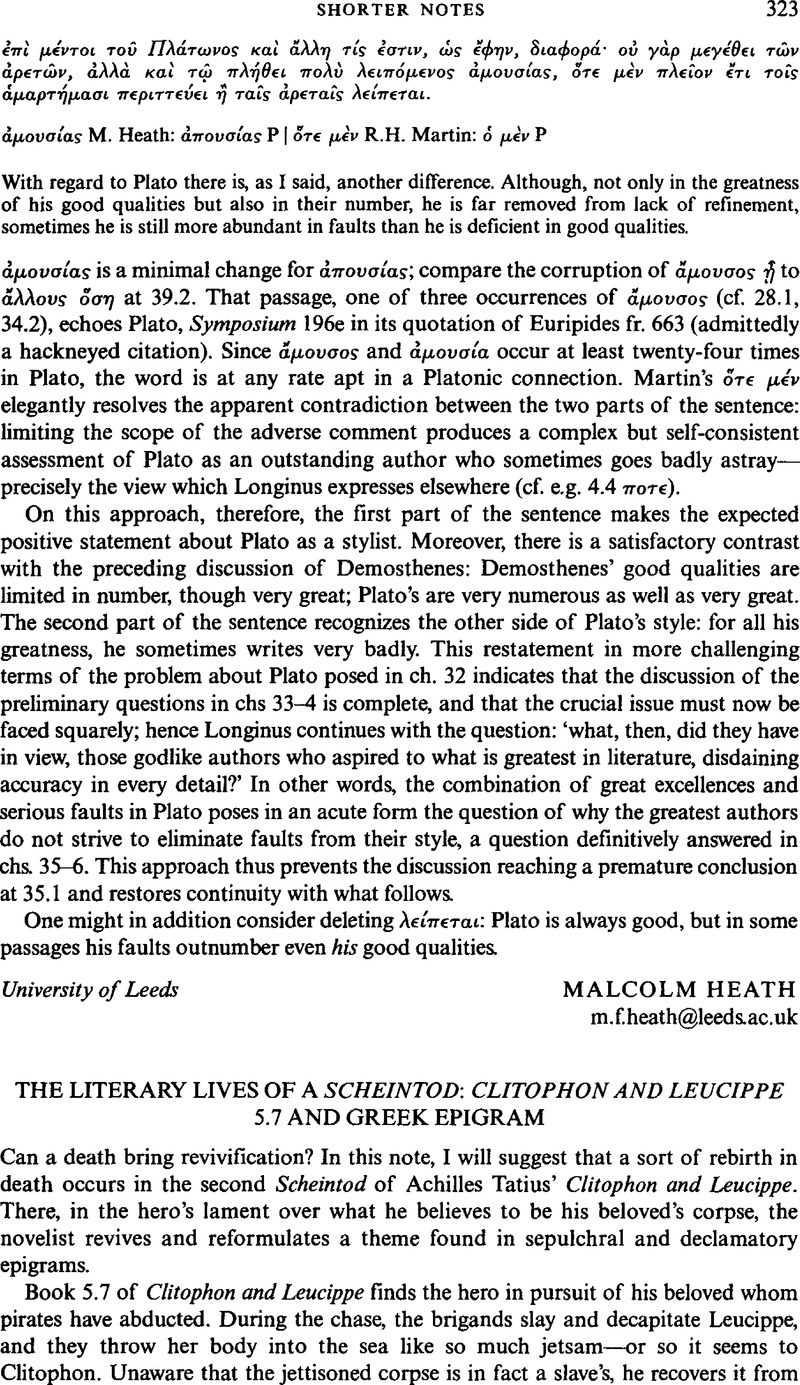No CrossRef data available.
Article contents
The literary lives of a Scheintod: Clitophon and Leucippe 5.7 and Greek Epigram
Published online by Cambridge University Press: 11 February 2009
Abstract

- Type
- Shorter Notes
- Information
- Copyright
- Copyright © The Classical Association 2000
References
1 Gaselee, S.(trans.), Achilles Tatius (London and New York, 1917), 253.Google Scholar
2 Anderson, G., Eros Sophistes: Ancient Novelists at Play (Chico, 1982), 27.Google Scholar
3 Durham, D. B., ‘Parody in Achilles Tatius’, CP 33 (1938), 15–17.Google Scholar
4 Vilborg, for example, is silent on the matter in her commentary, and Garnaud includes no annotation in his Budé edition.
5 G. Anderson (n. 2), 24.
6 Conte, G. B., The Rhetoric of Imitation: Genre and Poetic Memory in Virgil and Other Latin Poets (Ithaca, 1986), 42 and 88–90Google Scholar discusses allusion as a means to create a second mimetic register. While this work and Hinds's (see nn. 6 and 7) deal with Latin literature, nevertheless the principles expressed in them are applicable to Achilles Tatius and much ancient Greek literature, which is itself, of course, broadly intertextual. The equivalence of Latin and Greek imitative techniques is noted by Russell, D. A., ‘De Imitatione’, in West, D. and Woodman, T. (edd.), Creative Imitation and Latin Literature (Cambridge, 1979), 1.Google Scholar
7 Hinds, S., Allusion and Intertext: Dynamics of Appropriation in Roman Poetry (Cambridge, 1998), 40.Google Scholar
8 Ibid., 42.
9 This phenomenon is analysed fully in Tarán, S. L., The Art of Variation in Hellenistic Epigram (Leiden, 1979),Google Scholarpassim.
10 Heiserman, A., The Novel Before the Novel (Chicago, 1977), 119–30Google Scholar notably does not overlook this aspect of Achilles Tatius’ narrative art.
11 It should be noted that this line as well as the previous—δσμορος, ‘ς ’δ ^ναδ ιείλατοπ υρ τε καί ´δωρ—is subjected to particular censure in Page, D. L. and Gow, A. S. F., The Garland of Philip: Commentary and Indexes 2 (Cambridge, 1968), 351.Google Scholar Writes Page, ‘The last couplet is among the silliest in the present collection.’ It is perhaps no coincidence that this poem, similar as it is to Achilles Tatius, elicits the same critical scorn.
12 Curtius, E. R., European Literature and the Latin Middle Ages (Princeton, 1953), 293.Google Scholar
13 Longus’ relation to the epigrammatic tradition, for example, is well established. see Hunter, R., A Study of Daphnis and Chloe (Cambridge, 1983), 26–7CrossRefGoogle Scholar (on parallels with Zonas), 41–2 (on parallels with Agathias), and 72 (on parallels with Philodemus and Paulus Silentarius).




